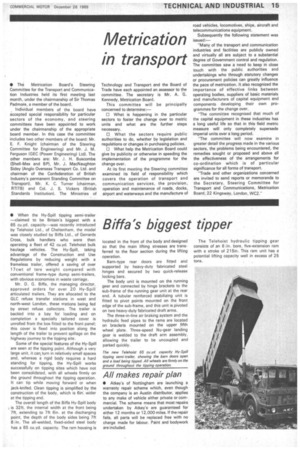Metrication in transport
Page 17

If you've noticed an error in this article please click here to report it so we can fix it.
• The Metrication Board's Steering Committee for the Transport and Communication Industries held its first meeting last month, under the chairmanship of Sir Thomas Padrnore, a member of the board.
Individual members of the board have accepted special responsibility for particular sectors of the economy, and steering committees have been appointed to work under the chairmanship of the appropriate board member. In this case the committee includes two other members of the board: Mr, E. F. Knight (chairman of the Steering Committee for Engineering) and Mr. J. M. Ferguson (GEC (Power Engineering) LW). The other members are: Mr. .1. H. Buscombe (Shell-Mex and BP), Mr. J. MacNaughton Sidey (Anglo Overseas Transport Co. Ltd. and chairman of the Confederation of British Industry's permanent Standing Committee on Transport), Mr. K. C. Turner (chairman, RTITB) and Col. J. S. Vickers (British Standards Institution), The Ministries of Technology and Transport and the Board of Trade have each appointed an assessor to the committee. The secretary is Mr. A. G. Kennedy, Metrication Board.
This committee will be principally concerned to determine:--- O What is happening in the particular sectors to foster the change over to metric units and what are the further steps necessary.
O What the sectors require public authorities to do, whether by legislation and regulations or changes in purchasing policies.
O What help the Metrication Board could give by publicity or otherwise in speeding the implementation of the programme for the change over.
At its first meeting the Steering committee examined its field of responsibility which covers the operation of transport and communication services, the provision, operation and maintenance of roads, docks, airport and waterways and the manufacture of road vehicles, locomotives, ships, aircraft and telecommunications equipment.
Subsequently the following statement was issued:
-Many of the transport and communication industries and facilities are publicly owned and virtually all are subject to a substantial degree of Government control and regulation. The committee saw a need to keep in close touch with the public authorities and undertakings who through statutory changes or procurement policies can greatly influence the pace of metrication. It also recognized the importance of effective links between operating bodies, suppliers of basic materials and manufacturers of capital equipment and components developing their own programrnes for the change over.
"The committee recognized that much of the capital equipment in these industries has a long useful life so that in this field metric measure will only completely supersede imperial units over a long period.
"The committee will now examine in greater detail the progress made in the various sectors, the problems being encountered, the remedies sought or proposed and above all the effectiveness of the arrangements for co-ordination which is of particular significance for all forms of transport.
"Trade and other organizations concerned are invited to send reports or memoranda to the Secretary, Steering Committee for Transport and Communications, Metrication Board, 22 Kingsway, London, VVC2,












































































